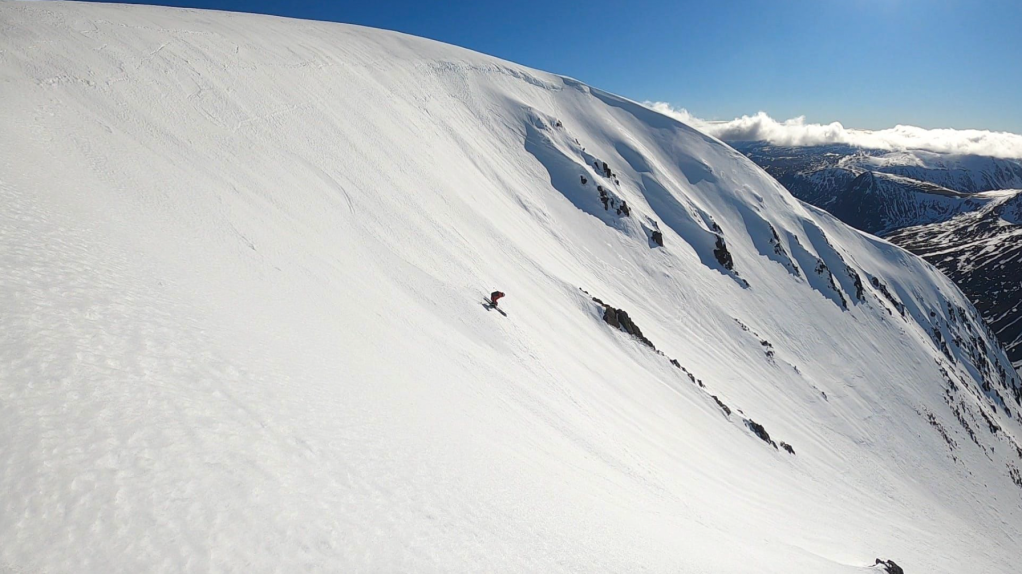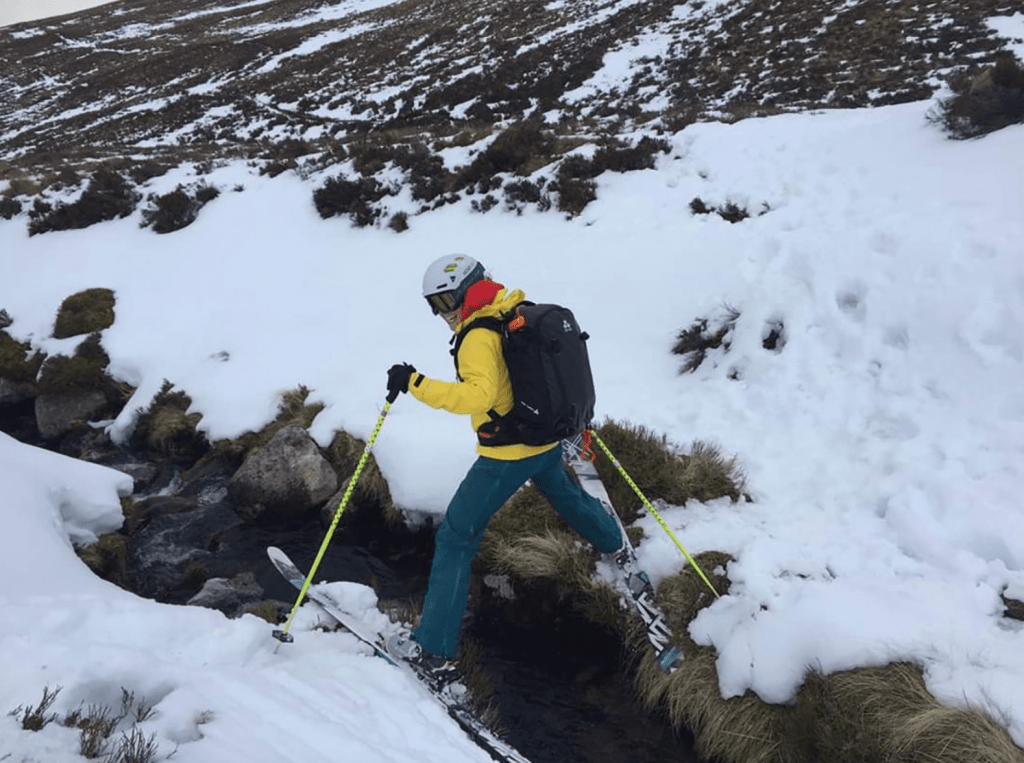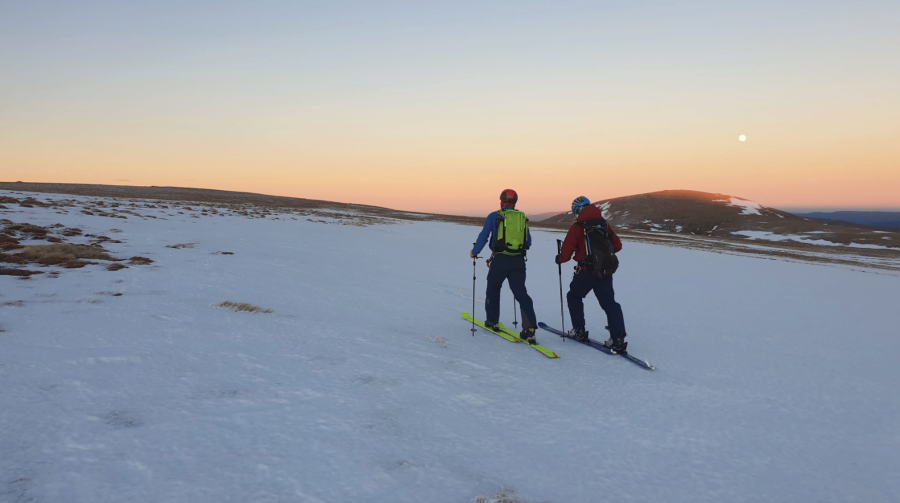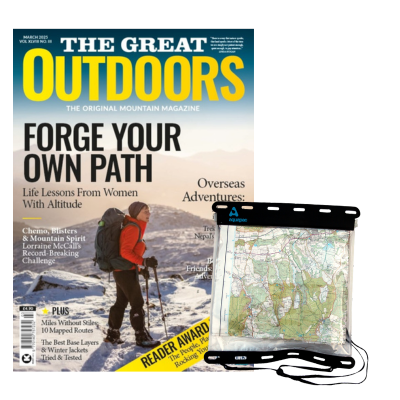Glenmore Lodge Senior Instructor Emma Holgate introduces you to the underrated yet thrilling efficiency of backcountry skiing through Scotland’s high places.
Scotland has charm, character and changeable conditions that make backcountry skiing here rewarding in often unknown ways when you first make plans and set out. On a blue bird day, when fluffy, fresh snow lays on a good base, there is nowhere better in the world. You may be able to link several summits, ski gully lines, or simply repeat an untouched, un-skied slope above lochs and mountains.
Main image: The setting sun after a long journey day through the Cairngorms | Credit: Emma Holgate
However, when we are challenged by the amount of snow, giving us a patchwork effect on the mountains, as well as changeable weather conditions, the need for optimism plus low expectations can bring with it great satisfaction. At times, the top layer of snow provides just enough to link turns and journey far – with an occasional need to pad across heather.
It can be as rewarding as it is entertaining and backcountry skiing always feels more efficient than walking. Backcountry skiing gives you a good all-round work out during which you gain the adrenaline from speedy descents as well as the feel-good factor when your turns work well and you remain upright.

Emma dropping in on a magical day with mega snow cover on Ben Macdui. Credit: Nathan White
Simply getting out into the snow and enjoying the winter environment can be so worthwhile when you make the effort to leave the comforts of a warm house. Backcountry skiing, also known as ski touring or ski mountaineering, offers a very fun and immersive experience compared to traditional downhill skiing.
Emma’s Essentials
Gain Experience
Before venturing into the backcountry, it’s crucial to have a solid foundation in downhill skiing. Develop your skills on groomed slopes and learn basic avalanche safety techniques as well as mountain navigation skills.
Invest in gear or hire kit
Backcountry skiing requires specialised equipment. Consider investing in or hiring the below:
- Avalanche Safety Gear: This includes an avalanche transceiver/beacon, shovel, and probe (TSP).
- Backcountry Skis, Skins and Bindings: These are designed for off-piste/all mountain conditions and the bindings allow movement for heading uphill with a skin attached to the bottom of the ski to prevent sliding backwards and allow forward momentum.
- Backcountry Boots: These are more adaptable so they can be flexible for up hill and provide better support through good adjustment for descending.
- Backpack: A backpack is essential for carrying your gear and essentials.

A Glenmore group enjoying early season powder on the east side of Cairn Gorm. Credit: Emma Holgate
Learn Avalanche Safety & Winter Navigation Skills
Understanding avalanche risk and safety procedures is paramount in backcountry skiing. Take a reputable avalanche safety course to learn about terrain analysis, weather forecasting, and rescue techniques. Alongside this you need to be able to navigate in the mountains to choose good routes and select safe areas to ski.
Choose the Right Location
Start with less challenging areas and gradually progress to more demanding terrain. Popular backcountry skiing destinations in Scotland include differing parts of the Cairngorms National Park.
Go with a Partner
Always ski with a partner or group. Having someone with you can provide assistance in case of an emergency.
Check Weather and Conditions
Monitor weather forecasts and snow conditions before heading out. Be aware of potential avalanche hazards and adjust your plans accordingly.
Respect the Mountain
Leave no trace and be mindful of the environment. Avoid damaging vegetation and wildlife habitats.

Challenges to overcome with thin snow cover. Credit: Emma Holgate
Understanding Scottish Snow Conditions
With proper preparation, knowledge, and respect for the mountains, you can enjoy a rewarding and unforgettable backcountry skiing experience in Scotland. To ensure a safe and enjoyable trip, it’s essential to understand how to deal with changeable snow conditions.
Variable Snowpack
Scotland’s snowpack can vary significantly, from soft powder to icy patches and hard crusts.
Frequent Weather Changes
Sudden changes in temperature, wind, and precipitation can dramatically alter snow conditions.
Avalanche Risk
Be aware of avalanche hazards, especially in steeper areas, or in areas in which an avalanche may end up if the snow was to release; known as avalanche terrain traps.
Local Knowledge
Consult with locals or experienced guides who are familiar with the specific area you’re planning to ski.
Be Flexible
Be prepared to adjust your plans based on changing conditions.

Skiing into the mist on Fiacaill a Choire Chais. Credit: Emma Holgate
Top Tips for Backcountry Skiing Beginners
Start on Easier Slopes
Begin on gentler slopes with less steep terrain to build your confidence and skills.
Learn to Use Your Skins
Skins are adhesive strips that allow you to climb uphill. Practice using them to ascend slopes.
Master Turns
Focus on mastering basic turns and controlling your speed in off-piste conditions.
Be Patient
Backcountry skiing requires patience and adaptability. Be prepared for changing conditions and unexpected challenges.
Ultimately, the reason you’ll love skiing in Scotland is personal. Whether it’s the challenge of the terrain, the beauty of the scenery, or the accessibility from where you live there’s something special about skiing in this beautiful country.
Glenmore Lodge is sportscotland’s National Outdoor Training Centre. Based near Aviemore in the Cairngorms National Park and founded in 1948, it exists to support individuals to access the outdoors safely and responsibly through providing skills training and inspiring adventure. Whether it’s trying a new way to enjoy the outdoors, a guided adventure, or professional experienced Instructors are ready to support everyone to develop their skills and achieve their aspirations in the outdoors. Learn more at glenmorelodge.org.uk.








